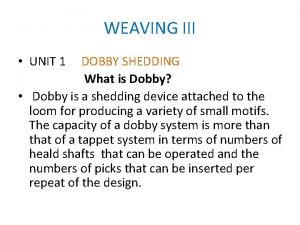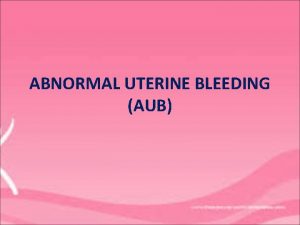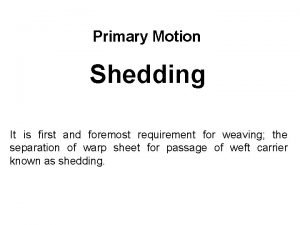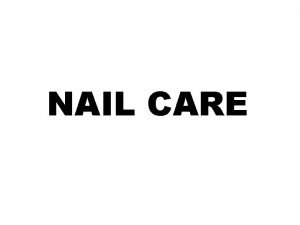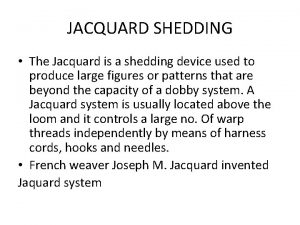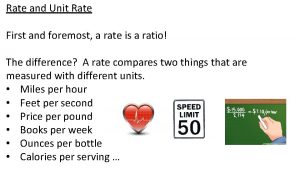Primary Motion Shedding It is first and foremost











- Slides: 11

Primary Motion Shedding It is first and foremost requirement for weaving; the separation of warp sheet for passage of weft carrier known as shedding.

Shedding Mechanism Positive shedding Negative shedding Concept of Positive and Negative shedding v If both up and down movement of healds is controlled by shedding mechanism then it is called Positive shedding. v If either of up or down movement of healds is controlled by a shedding mechanism and other movement is effect/reaction of first movement then it is called Negative shedding.

Types of Basic Shedding Mechanism Tappet Shedding Mechanism Cam Shedding Mechanism Dobby Shedding Mechanism Jacquard Shedding Mechanism Tappet Shedding and Cam Shedding is of similar type shedding mechanism. Sharing same type of limitations. There is fine line of difference between Tappet and Cam. Tappet is used where an intermittent movement required that means follower needs to have a dwell time (idle). Cam is used where follower continuously moving without a gap/dwell. Its movement follows the shape of cam. Follower Cam Shaft Tappet

Scope I Limitation of Basic Shedding Mechanism , , Tappet Scope§Simple mechanism §cheap §Easy to maintain §Reliable (less faults) §No limitation on speed Dobby Jacquard Scope§Controls 20 -28 shafts §Controls individual ends §Unlimited picks/repeat. §Unlimited patterning §Easy/Quick to pattern/weave (picks/repeat) possibilities. change than tappet/cam §Easy for pattern/weave shedding change but quite time consuming. Limitation§Complicated mechanism §Can control 8 -10 shafts Limitation§High initial cost §Use max. 8/ 10 §Simple principle but §High maintenance cost p i cks/repe a t §Slightly more liable to multiplicity of duplicated parts §Inconvenient for frequent produce fabric faults than §High initial cost tappet/cam shedding pattern / weave changes §High maintenance cost mechanism (more time needs to change (more moving parts) § Some limitation on loom gears/tappets) §more liable to produce faults speed §In exceptional cases, can than dobby use §Some limitation on loom § 12 -16 picks/repeat but at speed. lower speed.

Tappet / Cam Shedding Mechanism Positive tappet/cam shedding Negative tappet/cam shedding v If both up and down movement of heald is controlled by a tappet / cam then it is called Positive shedding. v If either up or down movement of heald is controlled by a tappet/cam and opposite movement is due to the effect / reaction of earlier movement then it is called Negative shedding.

Negative Shedding Mechanism If red leather strap is pulled in downward direction then green coloured leather strap winds on small roller If green leather strap is pulled in downward direction then red coloured leather strap winds on big roller

Negative Tappet Shedding Mechanism Big / Small Top Reversing Roller Front / Back Leather strap Front / Back Heald Shaft Warp Sheet drawn through Front Heald Shaft Warp Sheet drawn through Back Heald Shaft Lamb Rod J- Hook Treadle Lever Treadle Roller Shedding Tappet Bottom Shaft Fulcrum

Negative Tappet Shedding Mechanism Shedding tappets are mounted on bottom shaft exactly 1800 to each other. As bottom shaft rotates; corresponding treadle pressed roll get downward by the respective tappet owing to which both treadle lever toggles around the fulcrum point. Heald shafts are connected to treadle lever by lamb rod. As heald shaft moves in downward direction the corresponding leather strap unwinds from the top reversing roller and simultaneously other leather strap winds on other top reversing roller which lifts the other heald shaft. Note: Generally, back heald shaft is connected to a bigger tappet and bigger top reversing roller to maintain the same shed depth on alternate picks.

Front / Back Heald Shaft Position: Shed close Big / Small Top Reversing Roller Front / Back Leather strap Front / Back Heald Shaft Warp Sheet drawn through Front Heald Shaft Warp Sheet drawn through Back Heald Shaft Lamb Rod J- Hook Treadle Lever Treadle Roller Shedding Tappet Bottom Shaft Fulcrum

Heald Shaft Position: Shed open Small Top Reversing Roller Front Leather strap Big Top Reversing Roller Back Leather strap Front Heald Shaft Back Heald Shaft Lamb Rod J- Hook (Controlling Front Heald shaft) Treadle Lever Shedding Tappet (Controlling Front Heald) Bottom Shaft Treadle Roller (Controlling Front Heald) Fulcrum

Shed Reversal Back Heald Shaft: Down Position Back Heald Shaft: Up Position
 Ib
Ib Traffic throttling and load shedding
Traffic throttling and load shedding Foremost of noble ladies
Foremost of noble ladies What does being audience-centered involve
What does being audience-centered involve The foremost filipino abstract painter
The foremost filipino abstract painter Positive dobby shedding mechanism
Positive dobby shedding mechanism Halban disease irregular shedding
Halban disease irregular shedding Negative tappet shedding mechanism
Negative tappet shedding mechanism Shedding light on it reading
Shedding light on it reading Vaccinr shedding
Vaccinr shedding Non shedding surface meaning
Non shedding surface meaning Onyxhophosis
Onyxhophosis





